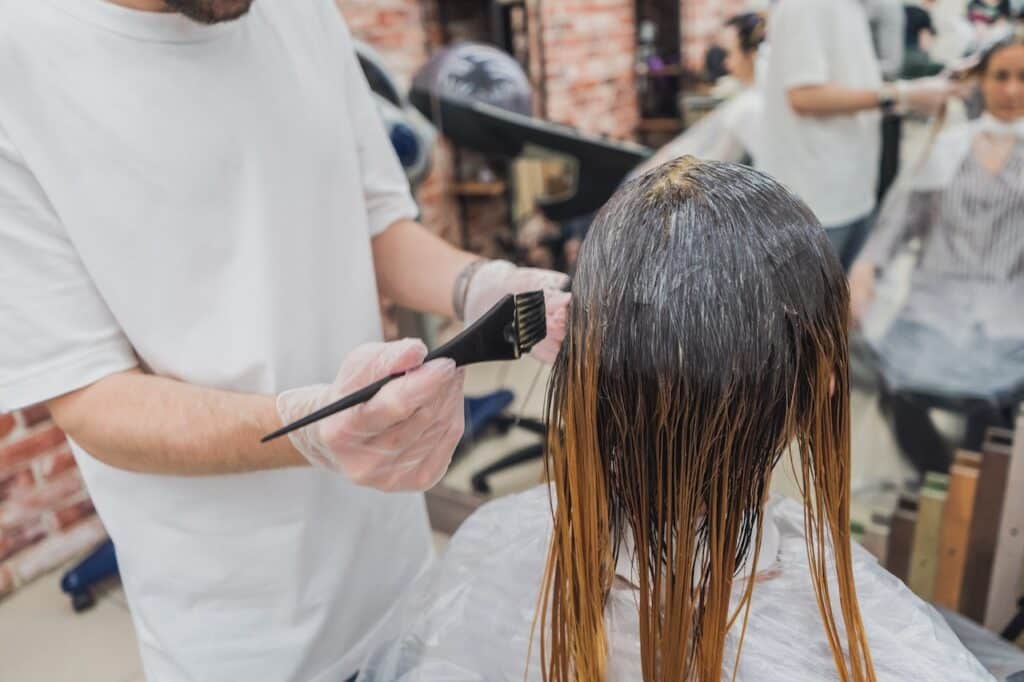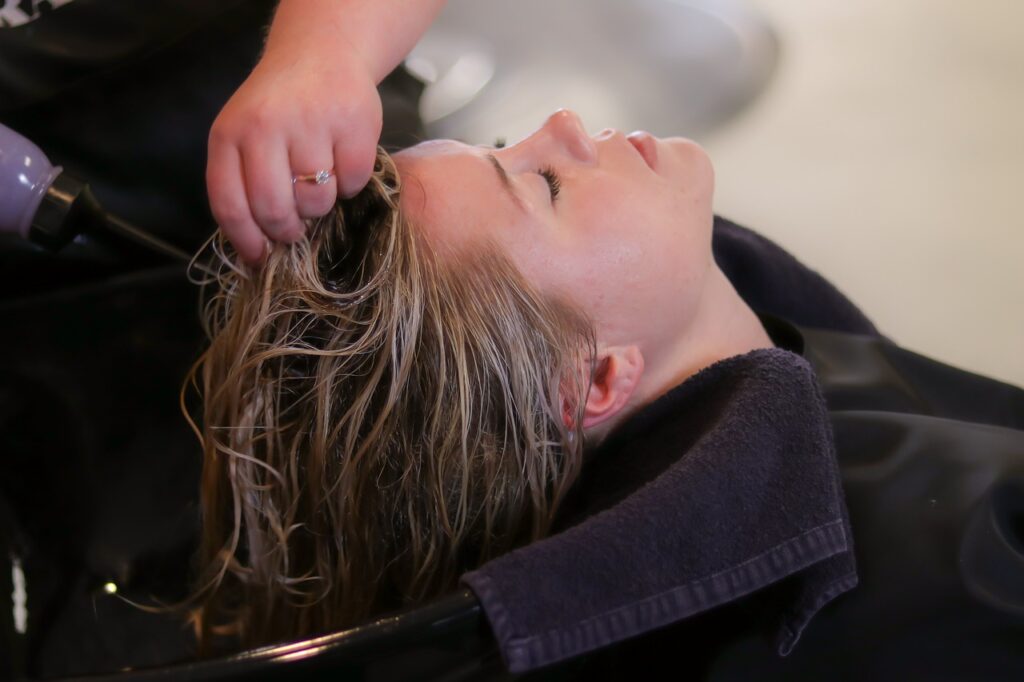Studies have indicated that the use of chemical hair straighteners can heighten the likelihood of developing uterine cancer, fibroids, breast cancer, and endometriosis. Regular use of chemical hair straighteners may also lead to detrimental side effects, such as weakened hair, intensified frizz, hair discoloration, and inflammation of the scalp.
What is Chemical Hair Straightening?
Chemical hair straighteners, such as creams and lotions, are specifically designed to permanently straighten curly hair by breaking down its protein structure. Unlike temporary methods, like heat straightening, chemical hair straightening keeps the hair straight until new hair grows in its place.
It is typically recommended to have professional stylists apply permanent hair straightening treatments due to the risky chemicals involved. While there are some at-home kits available, they usually contain less-potent formulas that may not be as effective.
The chemicals found in hair straightener products include formaldehyde, cyclosiloxanes, diethanolamine, parabens, phthalates, sodium hydroxide, benzophenone-3, and triclosan, as reported by the California Department of Toxic Substances Control. Numerous studies have tied these bad ingredients to an increased risk of medical issues, including fibroids, endometriosis, and cancer.
How is Chemical Hair Straightening Done?
Chemical hair straighteners employ a chemical mixture that targets the protein structures in the hair, also known as disulfides. Curlier hair tends to have more of these disulfide bonds, requiring stronger chemicals to break them down effectively.
Once the bonds break down, a stylist applies a neutralizing cream to adjust the disulfide structures. During this process, the stylist reshapes the hair to achieve the desired straightened look.
Mild chemical hair straighteners utilize gentler chemicals, which may not last very long, and may not be as effective for tightly curled hair. Certain kinds of straighteners, including Brazilian straightening or Japanese straightening, require you to avoid wetting or washing your hair for two to three days after treatment to ensure optimal results.

Chemical Hair Straightening Methods
There are many different chemical hair straightening methods. Keratin treatments and Japanese straightening are just two examples. These chemical straightening methods are suitable for a wide range of curl levels, ranging from tightly curled to slightly frizzy or wavy hair. Some chemical straightening treatments, commonly referred to as “relaxers,” are more effective for tight curls, but can also be more harmful to the scalp and hair shaft.
Chemical hair straightening methods include:
- Keratin Treatments: Also known as Brazilian straighteners. This method is not suitable for tightly curled hair. It typically lasts for three months and works by smoothing and straightening the hair without breaking down protein bonds. Some of these treatments may include formaldehyde.
- Japanese Heat Straighteners: This method utilizes ammonium thioglycolate. It’s straightening effects that can last up to 6 months. Compared to traditional chemical straighteners, Japanese heat straighteners cause slightly less damage. This method is also sometimes called thermal reconditioning.
- Traditional Chemical Straighteners: This chemical hair relaxer typically contains sodium hydroxide, which is used to straighten hair permanently. However, they are also known to cause significant scalp irritation and can damage the hair itself.
Chemical hair straighteners can be further categorized as thio relaxer, no-lye relaxer, and lye-relaxer, depending on their ingredients. Lye-relaxers contain the most damaging chemicals, and have the potential to cause the most harm to the hair.
Chemical Hair Straightening Side Effects
The use of chemical hair straighteners can lead to numerous side effects, both in the short term and long term. Scalp irritation, damaged hair, and allergic reactions are among the short-term side effects, while long-term side effects may include a greater risk of certain types of cancers and endometriosis.
Additional side effects associated with chemical hair straighteners include:
- Burns
- Hair damage
- Eczema
- Pain
- Frizzy hair
- Hair discoloration
- Scalp inflammation
- Scalp irritation
- Skin atrophy
- Hair loss
According to a study conducted by the NIH in 2019, people who use chemical hair straighteners have a 30 percent higher occurrence of breast cancer. A later study found those who used chemical hair straighteners were two times more at risk of developing uterine cancer when compared to non-users. African American women, in particular, face higher risks, as they tend to use hair straightening products more frequently than other consumers.
In response to these risks, women who have used chemical straighteners and subsequently developed uterine fibroids, endometriosis, breast cancer, and uterine cancer have filed chemical hair straightener lawsuits against manufacturers such as L’Oreal, Revlon, SoftSheen, and Sally Beauty. The plaintiffs argue that these companies knowingly sold harmful products without adequate warnings about the potential health risks.

How to Use Chemical Hair Straightening Products Safely
If you want to use chemical hair straighteners safely, it is highly recommended that you have a professional hair stylist apply the treatment. These professionals are trained in the proper application of chemicals with minimal harm to your skin and scalp.
If you choose to use a DIY kit for permanent hair straightening, it is crucial to carefully follow all of the instructions and take necessary precautions. Setting timers can help you avoid damaging your hair. To minimize skin irritation, applying Vaseline or hair oils to the scalp and hairline can be beneficial.
It is important to note that chemically straightening hair can result in long-term damage to your hair and scalp. With repeated application, the hair becomes weaker and more prone to breakage.
Chemical Hair Straightening Alternatives
A safer alternative to chemical hair straightening is using heat styling tools, like a flat iron, and hair serums that are free from harsh chemicals. While the results of heat styling methods may only be temporary, they pose fewer risks compared to hair straightening chemicals.
It’s important to note that heat styling still causes damage to the hair, but it does not carry the same cancer risks or reproductive issues associated with chemical hair straighteners. To minimize heat styling damage, it is advisable to apply a heat protection product to the hair, set the tool to the proper temperature setting for your type of hair, and ensure that it’s well-conditioned afterwards.
Is Chemical Hair Straightening Worth It?
Chemical hair straightening poses risks and side effects that should be carefully considered. Studies have linked the use of chemical hair straighteners to an increased risk of uterine cancer, fibroids, breast cancer, and endometriosis. Additionally, the chemicals in these products have been associated with numerous negative side effects. It is crucial to approach hair straightening chemicals with caution and prioritize safety.
Professional application of chemical hair straighteners by trained stylists is recommended for minimizing the risks involved. However, if using home kits, following the instructions and taking necessary precautions is essential. Heat styling can serve as a safer alternative, though it may only provide temporary results. It is important to remember that heat styling can still damage the hair, but it does not carry the same long-term health risks associated with chemical straightening.
Considering the potential side effects and risks involved, people should make informed decisions about their hair straightening choices and prioritize their health and well-being.
References
- https://blogs.unimelb.edu.au/sciencecommunication/2017/10/22/how-does-hair-straightening-actually-work/
- https://dtsc.ca.gov/scp/chemicals-in-hair-straightening-products/
- https://www.aboutlawsuits.com/wp-content/uploads/2022-11-15-MDL-Motion.pdf
- https://www.cnn.com/2022/10/24/health/hair-straightening-products-lawsuit
- https://www.lorealparisusa.com/beauty-magazine/hair-care/all-hair-types/relaxed-hair
- https://www.ncbi.nlm.nih.gov/pmc/articles/PMC6094529/
- https://www.niehs.nih.gov/news/newsroom/releases/2019/december4/index.cfm
- https://news.northwestern.edu/stories/2022/11/uterine-fibroid-growth-activated-by-chemicals-found-in-everyday-products/
- https://www.pantene.com.au/en-au/brandexperience/straight-talk
- https://pubmed.ncbi.nlm.nih.gov/36245087/
- https://www.sciencedirect.com/science/article/pii/S0365059621003147
- https://www.yahoo.com/video/chemical-hair-straighteners-linked-higher-234101030.html
